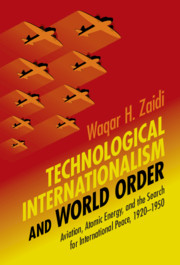 Technological Internationalism and World Order
Technological Internationalism and World Order Book contents
- Technological Internationalism and World Order
- Science in History
- Technological Internationalism and World Order
- Copyright page
- Dedication
- Contents
- Figures
- Acknowledgements
- Abbreviations
- Introduction: Machines of Peace
- 1 Invention, Interdependence, and the Lag
- 2 Controlling Scientific War
- 3 The Shape of Things to Come
- 4 Air Power for a United Nations
- 5 Wings for Peace: Planning for the Post-War Internationalization of Civil Aviation
- 6 A Battle for Atomic Internationalism: United States and the International Control of Atomic Energy
- 7 A Blessing in Disguise: Britain and the International Control of Atomic Energy
- Conclusion: Science, Technology, and Internationalism into the Cold War and Beyond
- Bibliography
- Index
Introduction: Machines of Peace
Published online by Cambridge University Press: 25 May 2021
- Technological Internationalism and World Order
- Science in History
- Technological Internationalism and World Order
- Copyright page
- Dedication
- Contents
- Figures
- Acknowledgements
- Abbreviations
- Introduction: Machines of Peace
- 1 Invention, Interdependence, and the Lag
- 2 Controlling Scientific War
- 3 The Shape of Things to Come
- 4 Air Power for a United Nations
- 5 Wings for Peace: Planning for the Post-War Internationalization of Civil Aviation
- 6 A Battle for Atomic Internationalism: United States and the International Control of Atomic Energy
- 7 A Blessing in Disguise: Britain and the International Control of Atomic Energy
- Conclusion: Science, Technology, and Internationalism into the Cold War and Beyond
- Bibliography
- Index
Summary
In February 1963, not long after the Cuban Missile Crisis, David Lilienthal gave a series of lectures on nuclear weapons at Princeton University. As a leading US policymaker on atomic matters in the late 1940s (including as the first Chairman of the Atomic Energy Commission), Lilienthal had been instrumental in shaping early policy on the atomic bomb. Now, in the aftermath of the deepest nuclear crisis to envelop the United States, he conceded that his, and society’s, earlier thinking on the bomb had turned out to be incorrect. ‘We have been following a myth’, he exclaimed, ‘an illusion about the Atom’.
- Type
- Chapter
- Information
- Technological Internationalism and World OrderAviation, Atomic Energy, and the Search for International Peace, 1920–1950, pp. 1 - 18Publisher: Cambridge University PressPrint publication year: 2021
